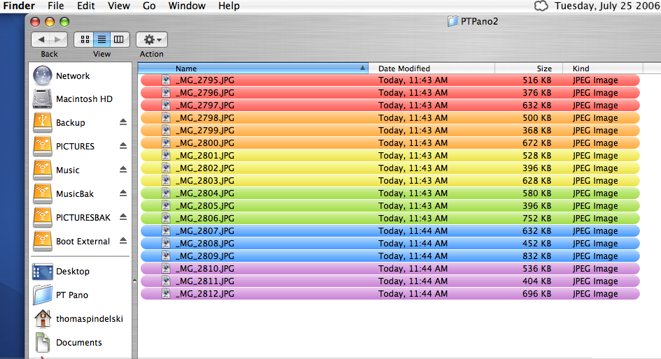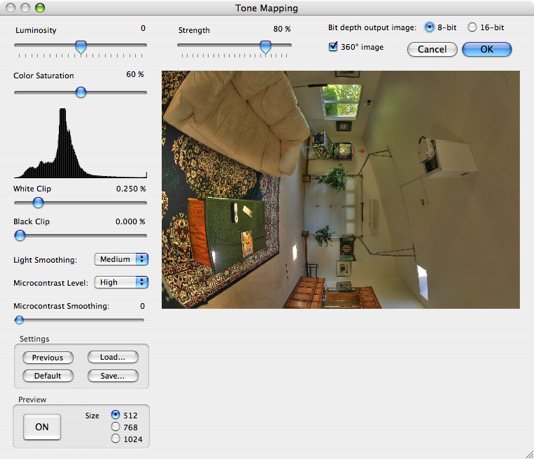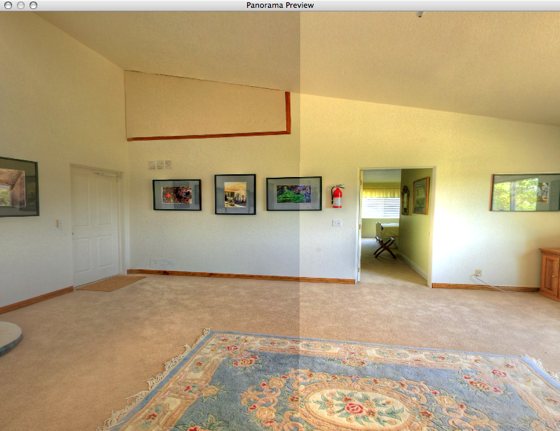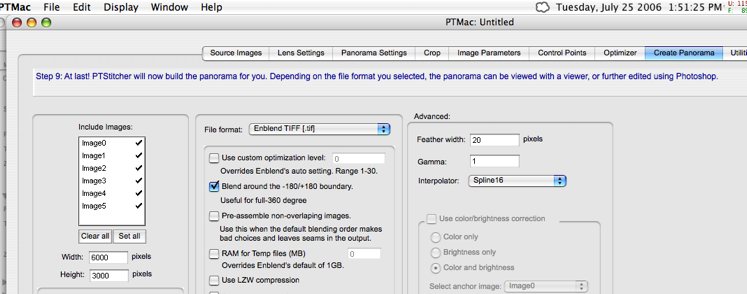Some serious heaviosity, as Woody Allen once remarked.
Putting it all together calls for one more test; namely, combining High Dynamic Range photography (HDR) with QuickTime panoramic images. Not just a dry academic exercise as I propose to put this to work on my first field trip to the redwood forests where the dynamic range can be simply astonishing. From shadows to highlights can be as much as ten stops. It gets very dark on the forest floor.
What better environment than the home theater with the drapes open to disclose a 100F day and brilliant sunshine outside? Thank God for the sunspot cycle.
I reprogrammed the Custom setting on the 5D’s mode dial to include three exposure bracketing for each picture, meaning normal, +2 stops and -2 stops and set the drive mode on Continuous. That way one press on the shutter fires of three shots in one second.
The eighteen constituent pictures (6 x 3 – I did not take zenith or nadir shots in this test) were then placed in their own folder in the Mac’s Finder and color coded to avoid mistakes (File->Color Label:>).

These are all at the lowest JPG quality setting on the 5D.
Here’s how the result of the HDR + tone mapping step in Photomatix looks:

I increased the default tone mapping saturation from 50% to 60% and checked the ‘360 degree image’ box – no idea what that does, but it seemed like a good idea. Photomatix lets you save settings to ensure repeatability between picture groups.
I ran the six HDR pictures through PTMac using the techniques set forth in my previous articles and, sure enough, the first pass was perfect as regards stitching. Except for one thing:

A thumping great big tone discontinuity as clearly visible above. Poking around it was obvious that this was at the junction of the first and last images.
Back in PTMac, I checked the box marked ‘Blend around the -180/+180 boundary’. No stopping me now!

This process generates a lot of files, so orderly housekeeping is in….order. Here’s the result:

The first 18 JPGs are the source images, followed by 6 tone mapped HDRs.The ‘.xmp’ file records the settings made in Photomatix for processing each. The ‘.mov’ file is the QuickTime video, the ‘.ptm’ file is the result of saving all data in PTMac, the ‘.tif’ file is the Enblend TIFF file from PTMac and, finally, the ‘.txt’ file is something PTMac generates and I have no idea what it does!
If you check the times, it’s 108 minutes from taking the first snap to having the movie file completed. (I saved the ‘.ptm’ file later – must be better about that in future).
Before putting the TIFF file through CubicConverter, I adjusted tones a tad in Photoshop then let her rip.
And you can click here for the result. Does Enblend rock or what? Don’t waste your time on non-Enblend stitching.
The home theater doubles as Le Gallerie Pindelski (French gives it that touch of class, don’t you think?). The pictures on the wall are by yours truly, all taken over the past twelve months, and in case you are wondering where my assistant, Bert the Border Terrier is, would you be walking between buildings with a fur coat on when it’s 100F outside? We are talking one pretty smart animal here.
Do I think I am God or what? Or, to once more quote Mr. Allen, “Look, I have to model myself on someone”.
Enough of this testing. It’s time to put all of this into practice. A real live, in the field, photography trip follows. That will involve 360 x 180 HDR pictures in the local redwood forest.